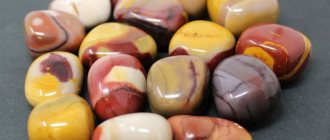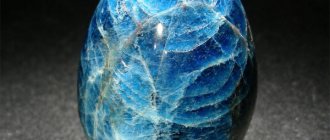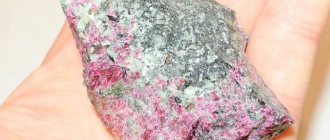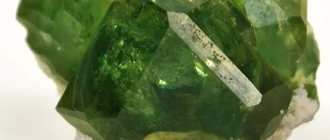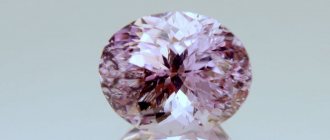Homology experts have established the order of construction of precious and semi-precious minerals, which is influenced by: fashion, properties, color preferences, cost, division by deposit, etc. The garnet stone remains a perennial favorite, ranked in the second class (out of five) after diamonds and corundums (“truly precious minerals”). The work of astrologers and lithotherapists has led to the conclusion: garnet stones are a universal means of harmonizing the human energy field. Indications, contraindications, and safe wearing combinations have been established. The mineral of passion and depth will change color or crack if something goes wrong.
History and origin
It is impossible to tell the full story of the pomegranate briefly, it is too voluminous. A description of the stone is found in the records of medieval scribes from Europe, Persia and Arabia. It is found in gold jewelry of ancient Scythia; the inhabitants of ancient Rome were familiar with it, who gave the stone the name “carbuncle” and their neighbors, the Hellenes, who called it “anfrax”.
Garnet stone
The ancient Greeks most often worked with the dark variety of garnet. The name "anfrax" means "coal". At the same time, the ancients often called all minerals of red color, corresponding structure and transparency, garnet.
Noble spinel, some varieties of hyacinth and other scarlet or crimson crystals were confused with garnet (or, more precisely, they were not distinguished from it).
True, garnet has always been contrasted with ruby, which is harder and has a different, more perfect play of color. It began to be considered a true precious stone only in the 17th century; before that it had rather a utilitarian meaning. Ancient people valued the medicinal properties of the gem more, in particular the ability attributed to it to stop bleeding.
In Europe and the Middle East, mainly the red variety of stone was mined, two subspecies of which were later called pyrope and almandine. The mineral received its modern name thanks to the “Phoenician apple” - the pomegranate fruit tree, for the characteristic garnet color of its crystals. The word “granatus” itself means “grain-like” - referring to the dark red translucent grains of this plant. Only at the beginning of the Renaissance did scientists discover that garnets can be pink, purple, yellowish, colorless, and even black or green; the latter are sometimes confused with chrysolite.
In medieval Rus', this stone was called “bechet” or “venisa”, sometimes “worm” or “wormy yacht”.
Interesting Facts
- A.I. Kuprin, a connoisseur of precious stones, knew the properties of gems well and won any bet to determine their type. The writer applied his knowledge about the medicinal benefits of pomegranate to a military hospital, which he opened in his home during the First World War. In the story "Shulamith", through the legend of the love of the Israeli king Solomon for a poor grape picker, the sacred anthrax is presented as a jewel, a talisman and a medicine. The wise king told the girl about the properties of pomegranate - the stone of love and blood. The red flame of anthrax heals the heart, brain, and soothes the stomach. Wearing a ring with a magical mineral gives your face a glow.
- An explanation for why pomegranate is used in the treatment of blood and heart diseases was found in ancient Indian teaching. Buddhists believe that the mineral appeared on Earth after the death of a supernatural being who sacrificed himself to save the Balance between good and evil. Blood and heart turned into ruby and garnet. The healing properties of red minerals began to be associated with the organs of the human body.
- In ancient Tibet and China, wounds were cauterized using sunlight passed through garnet crystals.
Physicochemical characteristics
From the point of view of physicists, chemists and geologists, all minerals of the garnet family have a complex molecular structure. The basis is silicon oxide in combination with various metals - mainly iron, manganese, magnesium, and less often aluminum and chromium. A separate group of garnets contains calcium and metal compounds.
The color of the crystal depends on the metal impurities. Iron gives a red color, manganese gives a yellowish color, aluminum lightens the color, and an admixture of titanium makes it black. Calcium garnets are mostly yellow or green.
Differences in the chemical composition have little effect on the properties of pomegranate; they are approximately similar in all types. This stone has a hardness of up to 7.5 Mohs, a vitreous luster and a medium density.
Garnet stones
| Formula | X3Y2Z3φ12, where X are elements in the dodecahedral position; Y – elements in octahedral position; Z – elements in tetrahedral position; φ – O, OH or F |
| Color | Very rarely colorless; mostly painted in different colors, with the exception of blue |
| Shine | Glass, greasy, resin, diamond |
| Transparency | Transparent, translucent, see-through |
| Hardness | 6 6,5 7 7,5 |
| Cleavage | Not visible |
| Kink | Conchoidal, uneven |
| Density | 3,4 — 4,3 |
Mining locations
The places where garnet is mined have different geological characteristics. Some subspecies of this mineral, for example pyrope, are mined along with diamonds, in diamondiferous rocks (kimberlite pipes). Such deposits are located in South Africa and Russian Yakutia. The most common subspecies, almandine, is found throughout the world in shale and gneiss rocks, both in the thickness of mountain ranges and in placers. Calcium garnets, such as grossular, are often found in limestone rocks.
In Russia, the largest concentrations of garnets are located on the Karelian Isthmus and on the Kola Peninsula, mainly almandines. In the Urals, a rare and beautiful uvarovite garnet is mined.
The largest garnet deposits in the world, besides our country, are located in the USA and Canada. They are found in Brazil, Madagascar, Finland, Azerbaijan and some European countries. But the gem mined there is distinguished by its unique color.
Mineral deposits
Garnets are mined in many countries:
- Russia – Chukotka, Ural (green uvarovites), Yakutia (fiery red pyropes), Kola Peninsula.
- Germany.
- Mexico.
- Australia.
- Zambia.
- India.
- Brazil.
- Sri Lanka.
- USA.
- Other countries.
This is interesting!
In the USA, a unique variety of pomegranate is mined, called “Ant” or “Arizona”. The first name is associated with the method of extraction. Small pebbles weighing no more than 1.5 carats are carried from the depths of the earth to the surface by ordinary ants. They use them in the construction of anthills. Interestingly, it was not possible to find the “ant” pomegranate using the mine method.
Colors and varieties
Classic garnets have all shades of red; this is their main distinguishing feature. Unlike ruby, the fruits of the “Phoenician apple” are not so transparent; they have a slight moiré haze. Some specimens are purple, some are black, others are distinguished by their play of green tint.
Main varieties of pomegranate:
- Pyrope. One of the few that matters in jewelry. Rich red color, closer to purple.
Pyrope stone - Almandine. The most common of all garnets. Red almandine differs from pyrope in its lighter shade, but the stone can also be purple and almost black.
Almandine stone - Spessartine is brownish, orange, sometimes yellow. Mined in Germany.
Spessartine stone - Grossular. In Latin - "gooseberry". It got its name because of its color similarity to gooseberries; it is the same greenish-brown with hints of yellow. There are grossulars of emerald shades.
Grossular stone - Uvarovite is a Ural garnet of rich emerald color.
The stone will boil down - Hessonite is the color of honey.
Hessonite stone - Andradite is a Brazilian variety of garnet. There are different colors - red, yellow, greenish.
Andradite stone - Melanitis is black.
Melanite stone - Leucogranate is a transparent stone. It is more important for industry than for jewelry.
Leucogranate stone
It is difficult to distinguish a garnet of an “unusual” color from another precious or semi-precious stone. This can only be done in the laboratory.
Artificial pomegranate
Since this stone is important for industry - from the manufacture of abrasives to the creation of laser emitters - they learned to synthesize it back in the first half of the 20th century. Artificial garnet is not a fake in the full sense of the word, since it was not originally intended for use in the jewelry industry.
Moreover, using high-quality synthetic garnets to imitate real ones is pointless: due to the nature of the production process, the price of an artificial garnet that looks similar to a natural one is comparable to the price of a natural one. But thanks to synthesis, it is possible to grow stones of any color and shade, for example, dark blue (such garnets do not occur in nature).
Synthetic stones are usually used for industrial needs. They are added as additives to mortars, used to create various elements in microelectronics, laser systems are constructed based on them, and so on.
Medicinal properties
The healing properties are mainly attributed to the red varieties of this stone - pyrope and almandine, since these are the most ancient known subspecies of garnet.
Less often they talk about grossular.
The importance of garnet in lithotherapy is great, but you need to be aware that in most cases this does not mean any stones, but red ones. And their main property is based on the ancient rules of sympathetic magic. This means that like influences like - red as blood, the garnet has power over blood.
It means that:
- pomegranate can stop wound bleeding;
- it promotes accelerated regeneration;
- it normalizes blood pressure.
In addition, wearing a garnet in gold is beneficial for health as a preventive measure against colds - it prevents many pulmonary diseases. A stone set in silver is suitable for people who have weak immunity and, due to this, an increased risk of contracting a sore throat, pneumonia or other infectious diseases.
Gold ring with garnet
Pomegranate is able to give its owner vigor and vitality to cope with almost any illness or stress.
Some lithotherapists recommend wearing a gold garnet ring on the middle finger of the right hand as a way to relieve pain from frequent migraines.
Magic properties
The magical properties of the stone primarily include the ability described above to influence the blood, as well as fill its owner with energy and give strength for new achievements. No wonder rings with garnets were very popular among the crusader knights who fought in difficult and unusual conditions for Europeans.
The ancient magic of the pomegranate patronizes people who are strong, purposeful, but at the same time - the key condition - fighting for a good cause.
A person’s occupation can be anything - warrior, politician, businessman, artist. There are two key conditions: he must have a creative beginning, that is, bring something new into his activities, constantly improve and move forward, and he must not have evil, dark thoughts. Garnet is a stone of fair combat, frontal attack. He can destroy a swindler and an intriguer, lead him into a cycle of intrigues he has woven and confuse him. Often the gem brings such people to a severe mental disorder, which in the material sphere goes hand in hand with bankruptcy and ruin.
Red pomegranate helps those people who want to develop themselves and develop their business.
It is very important for the owner of this stone to have a clear, formulated goal, otherwise a “confused” stone will push the owner from side to side, in some cases even provoke diseases.
Pomegranate amulets, talismans and amulets are capable of:
- help the owner identify hidden enemies;
- heal wounds;
- protect from water hazards;
- help in love affairs, especially in winning the heart of an unapproachable girl;
- enhance the charisma and charm of the owner.
Please note: Garnet jewelry is dangerous for some people. This stone enhances the primitive nature of a person, awakens the predator, aggressor, and beast in him. In this way, it helps people suffering from a lack of aggression (in some life situations this is a minus), but those who are naturally aggressive, with a strong “beast” inside, are turned into monsters by the pomegranate.
Zodiac compatibility
Astrologers believe that according to the horoscope, garnet corresponds to the fire element, although in this case it means only the red variety of the stone. The garnet stone in different forms refers to different zodiac signs.
Red stones - pyrope and almandine - are suitable for Leo, Capricorn, Sagittarius, and to a lesser extent - Virgo. At the same time, he lacks compatibility with water signs, especially Pisces and Cancer. Taurus also does not like this mineral.
Grossular by zodiac sign is suitable for everyone. This is one of the most peaceful stones, but its strength is less than that of its scarlet counterparts.
| Zodiac sign | Compatibility |
| Aries | + |
| Taurus | — |
| Twins | + |
| Cancer | + |
| a lion | + |
| Virgo | + |
| Scales | + |
| Scorpion | +++ |
| Sagittarius | + |
| Capricorn | +++ |
| Aquarius | + |
| Fish | + |
(“+++” – fits perfectly, “+” – can be worn, “-” – is strictly contraindicated)
Favorable time to purchase
Astrologers recommend purchasing pomegranate on the 8th, 19th, 30th lunar day. A stone purchased on the 8th day will make the owner attractive and alluring. The purchase will protect you from malevolent entities from other worlds. A copy will help in meditation and will tell you the true purpose of a person.
A stone purchased on the 19th day will display magical qualities and make the person pleasant and respectful to the public.
A copy purchased on the 30th day is a powerful amulet filled with mystical power.
It is preferable to buy a stone according to the lunar calendar
Price
The price is determined by the size, grade, and quality of the sample. The cheapest ones cost about 100 rubles apiece; precious and collectible pieces will cost tens of thousands of dollars per carat.
Compatibility with other stones
In this matter, everything is not easy for pomegranate. The fact is that different types of this stone belong to different elements. Pyrope, almandine, grossular are Fire stones. But, for example, uvarovite is the stone of Air. Fire and Air are friendly elements, but Fire, unlike Air, does not combine with Earth.
So, you can choose stones that suit each other according to this scheme. All grenades combine with:
- diamond and diamond;
- ruby;
- coral;
- pyrite;
- heliolite;
- rock crystal;
- topaz;
- amethyst;
- carnelian;
- golden beryl.
Garnet beads
You should not wear them with Water stones - a mutual contradiction will arise (not so strong in the case of uvarovite).
In jewelry, first of all, avoid combinations of garnet:
- with emerald;
- opal;
- aquamarine;
- moonstone;
- alexandrite;
- pearls;
- tourmaline;
- zircon.
In addition to uvarovite, it should also be used with caution. These include:
- jasper;
- chalcedony;
- agate;
- onyx;
- malachite;
- turquoise;
- obsidian;
- morion.
As well as other opaque minerals.
Application in products
Currently, the market is saturated with products containing garnet, mostly almandine. Such jewelry is worn mainly by women.
For men who want to look impressive, for example, gold or silver cufflinks with dark pyrope are made.
Excluding industrial applications, it is used as inserts in rings, earrings and pendants. Cut - cabochon or diamond. Sometimes the processing is reduced to a minimum: for example, heavy beads made from uncut, but only polished, red garnet look beautiful.
Pomegranate cufflinks
In addition, this stone was often used for precious inlays in luxury items.
Rules of care
The product should feel the attention of its owner, so it is worth keeping it clean. Do not use abrasive or chemical compounds for cleaning. It is better to use the services of jewelry workshops to clean jewelry.
Basic rules that the owner of a dark garnet amulet must take into account:
- From dust and dirt settled on the surface of the stone, its magical and healing properties are lost. When removing jewelry, you should wipe it with a regular soft cloth dipped in soapy water. If the jewelry is heavily soiled, mechanical cleaning in a workshop is necessary.
- Garnet is capable of collecting all the negativity sent to the owner, so the stone must be cleaned regularly.
- You should not take a bath with the product; the quality of the stone is lost with prolonged contact with water. For this reason, it is not recommended to use natural mineral to decorate rings.
- Exposure to direct sunlight causes the surface of the garnet to fade. It should be stored in a linen bag.
Only natural stone can work correctly, and due to its high cost, garnets are often counterfeited. You need to buy jewelry that should serve as a talisman in trusted jewelry stores, checking the certificate of conformity. If you follow certain care rules and recommendations regarding wearing the product, pomegranate will help make your life easier and happier.
How to spot a fake
The cost of a pomegranate is not very high, but it is counterfeited.
It is quite difficult to distinguish natural stone from synthetic stone.
Their hardness, density and shine are the same; moreover, synthetics can be harder. To determine the authenticity of a stone, use one of the following rules:
- rub a piece of stone on wool - a natural mineral, like an ebonite stick, becomes electrified, a synthetic one does not;
- natural stone has a heterogeneous color, and artificial stone has a bright color;
- Specimens larger than a coffee bean should be considered suspicious - such stones are rare in nature.
Natural stone differs from painted glass in hardness - it is much harder.
Where is the gem mined?
The breed is obtained in the following countries:
- India;
- Namibia;
- Russia;
- Brazil;
- Finland;
- Canada;
- Azerbaijan.
Known Russian deposits:
- Khizowara;
- Sharivara;
- Sinerechenskoe;
- Kitelskoe;
- Akhmatovskaya mine.
Several valuable mineral deposits are known in Russia
Collectible crystals are obtained from:
- Primorye;
- Karelia;
- Dashkesan;
- Chukotka.
How to wear and care
Rings with garnet are worn on the middle finger - if the frame is made of silver, then on the left hand, if made of gold, then on the right hand. There are no specific requirements for wearing beads, pendants or earrings, with the exception of combinations with other stones.
Gold ring with garnet
A dirty product should be washed with a weak soap or saline solution. You can add a couple of drops of ammonia. Wipe with a cloth, do not use hard sponges or abrasives. Store in a separate bag.
Artificial pomegranate
This variety of pomegranate from the laboratory is used only for industrial needs. Jewelers do not use synthetic garnet because the production method is expensive (the cost is equal to the cost of a natural stone). And manufacturers use garnet in construction, microelectronics, laser machines and other equipment.

